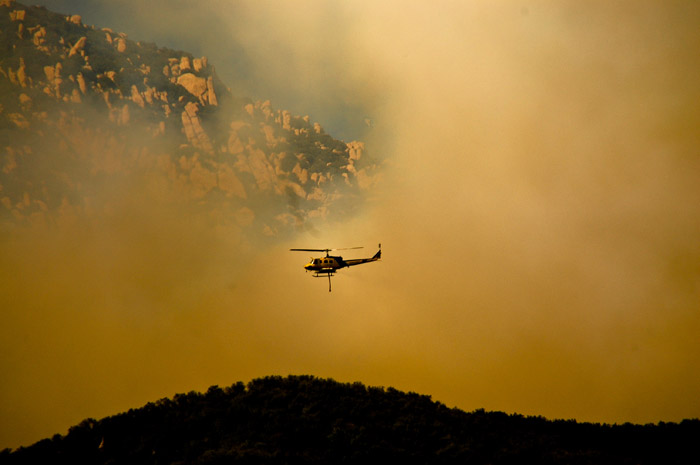
© 2009 Michelle Wong. All rights reserved.
The smoke from the huge Jesusita Wildfire in Santa Barbara,
California dwarfs a helicopter dispatched to fight it.
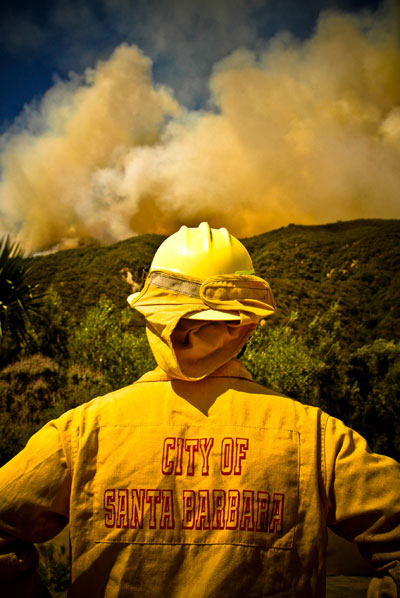
© 2009 Michelle Wong. All rights reserved.
The wildfire had already raged for several days, consuming everything in its path: trees, shrubs, and million-dollar homes. On the third day of chaos we packed his belongings into my Honda – everything that fit into the backseat and trunk, leaving the rest to chance, and the skills of the Santa Barbara Fire Department. With smoke and soot in the air and in our lungs, sweat dripping out of our pores from the blaze that was only a block away, he shoved the last backpack — books — into the backseat and took one final look at the home he would leave behind.
“I know — ” he said. “Let’s go get some pictures!”
And into the blaze we went.
A Santa Barbara City fireman waits for the sundowner winds to push the fire down the foothills north of the city.
Michelle Wong’s camera is a beat up machine: a used Nikon D70S body, with lenses cobbled together from various online discount stores. The rubber grip on the lens is loose. The auto focus stopped working about a year and a half ago.
And yet, in the four brief years Wong has been taking pictures with this camera, his first DSLR, he and his camera have seen more action than many professional photographers see in their careers. He’s taken pictures of the likes of the Dalai Lama and President Barack Obama. He’s captured disasters like the aftermath of Hurricane Katrina in New Orleans and the Jesusita Wildfire in Santa Barbara. He’s taken it on trips crossing several countries in South America on foot, or disappearing into the bowels of Cite Soleil, the tent city in Haiti. He’s also turned his lens on lavish weddings and high fashion.
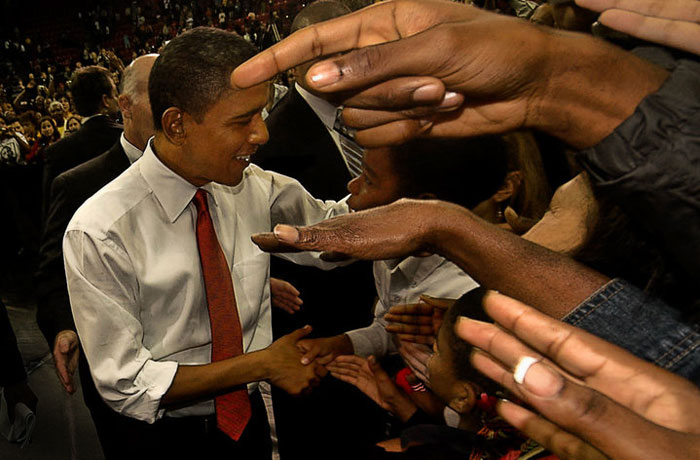
© 2009 Michelle Wong. All rights reserved.
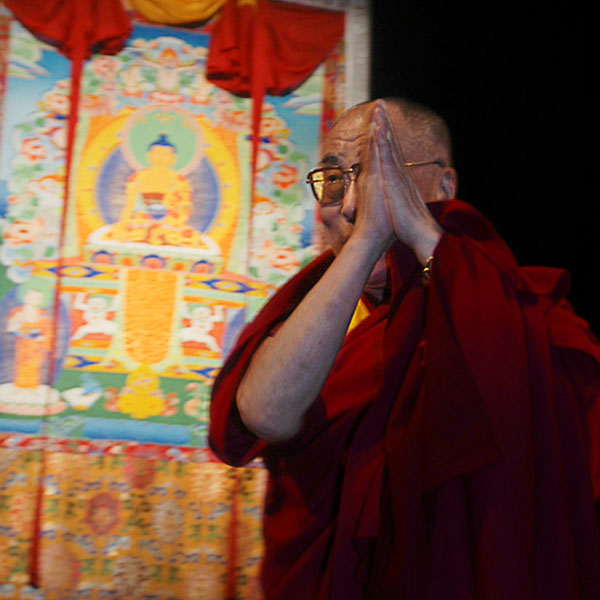
© 2009 Michelle Wong. All rights reserved.
It started out like it does for many photographers – a curiosity that becomes a raging habit (along with the gear-lust), but few take their passions as seriously as Wong does.
“I didn’t buy the camera without the intention of not doing it seriously,” he said. The local junior college was teaching it as a trade, he said, so he started out in the journalism department.
The Earliest Days
“I’ve seen a lot of crazy (shit),” said Wong. Born into a difficult childhood in one of the poorer sections of Costa Rica, Wong was working full time to support his mother and sister by the age of nine. There was little to shield him from the grim realities of poverty in the Third World, and all the harshness it brought: violence, pain, and worse, helplessness. His conditions only fueled his desire to see what else there was in the world, and what stories could be told.
“It’s way easier for me to say what I want to say through a photograph than speaking. It means communication,” he said.

© 2007 Michelle Wong. All Rights Reserved.
Above: Wong’s first photos were of a protest in Los Angeles. Though it distorts perspective somewhat, the wide-angle lens also allows for more context and drama in a situation.
Right: A Bolivian woman, one of many indigenous women who are losing their lives and families to mine-related diseases in the town called Cerro Rico.
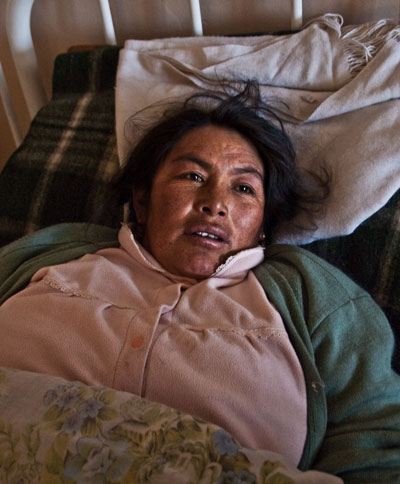
© 2010 Michelle Wong. All Rights Reserved.
Taking the Photo
If you want to be a good photographer, says Wong, you need to get out and shoot. Sitting in a class discussing theory in a photography school only goes so far, he adds.
“What you need to do is get outside.” With very little in the way of formal training, he’s had to relentlessly self-critique, pitting his work against that of those who have ten times more experience. As a result, his photos show a steady progression of style and technique, as he refines his approach to the work.

© 2011 Michelle Wong. All rights reserved.
An inmate at La Reforma, Costa Rica’s maximum-security prison.
For photojournalistic pieces, Wong has learned to find out what the publication wants, or if a self-directed project, to focus on the reality of the situation. Such was his self-direction when he went to Haiti in 2011, a year after the massive quake leveled half the buildings in Port-Au-Prince.
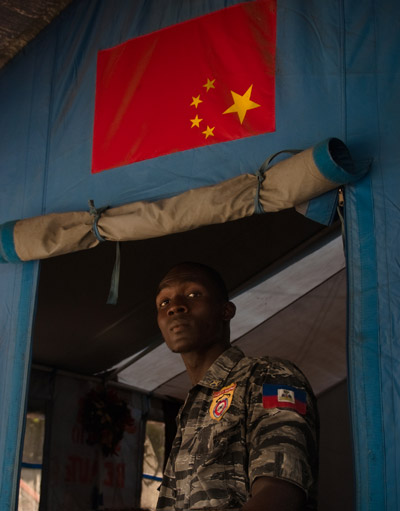
© 2010 Michelle Wong. All rights reserved.
“In Haiti, I knew the topic I wanted to shoot would be gangs because I saw a documentary by National Geographic. But, I knew I could get closer to them,” said Wong. The truth, it turned out, would be more complex.
“In the end, they still want what everyone else wants,” he said. Few would make it out of that violent, impoverished place called Cite Soleil far enough to approach the good life, and organization was necessary for survival, he added. It’s a hard-won and unlikely perspective: Wong was kidnapped and held at gunpoint on his second day there, by thugs who thought his skin coloring represented a large ransom. After escape, he managed to befriend members of an organization with good intentions albeit questionable means.
A member of the Haitian police force stationed in Cite Soleil, a tent city that emerged after the devastating earthquake of 2010.

© 2011 Michelle Wong. All rights reserved.
Heroes and villains are sometimes hard to tell apart in the streets of Port-Au-Prince, Haiti. Wong managed to get close enough to a group of young Haitian men who organized in Cite Soleil to raise funds to help rebuild their community. They also to defend their neighborhoods from those who would rob from them.
Polishing the Work
The computer is an indispensible part of photography, said Wong, who started out by leaning heavily on four elements from the same Photoshop Lightroom menu – Brightness, Saturation, Exposure, and Contrast – to improve his photos. What composition and exposure cannot convey at the moment of image capture may yet be expressed through a good edit.
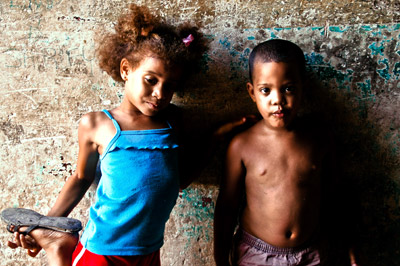
© 2008 Michelle Wong. All Rights Reserved.
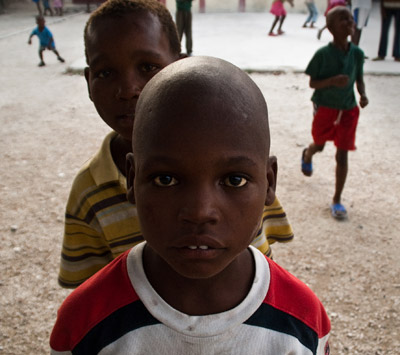
© 2011 Michelle Wong. All Rights Reserved.
The importance of photo editing struck Wong fully when he worked a brief term as an intern for legendary photographer Steve McCurry in his New York offices. Each photo chosen is subject to analysis and a series of edits and editors.
“People who think Photoshop is cheating are usually those who don’t know how to use it very well,” said Wong. The sophistication in editing and high level of attention on already well-composed and well-exposed photos inspired Wong to continue to expand his own editing skills.
Upper left: A pair of street children in Havana, Cuba take the time out to stand still for a photo.
Left: Over the years, Wong’s editing style has evolved from the high contrast global editing style of his picture of Cuban street children (2008) to the more focused and sophisticated style he uses with lighting and skin tones in his photo of Haitian kids.
This Moment
These days, Wong’s photography has been more conceptual, shooting fashion for designer Fabian Zitta, surrounded by models, makeup and haute couture.
“I ask the designer what the most important ideas are before I shoot, because I don’t want them hovering over me while I work,” he said. “It’s a mistake to have the designer dictate to you how to shoot because they don’t see things the way you do.” Their art is in the clothes, he said, while the photographer has to keep his eye on other things in the frame as well.

© 2012 Michelle Wong. All rights reserved.
In fashion, everything in the frame serves to bring out
(or at least not distract from) the designer’s, or publication’s, concept.
Wong has found what could be a happy medium in the form of his preferred style of photography: portraiture. Whether taking photos of models in staged situations or people on the street under more spontaneous circumstances, portraits allow him to consider elements like contrasts, setting and compositions, without sacrificing what intensity and intimacy the human face could convey.
“What I like most are expressions and gestures,” he said. “Faces say a lot of things.”
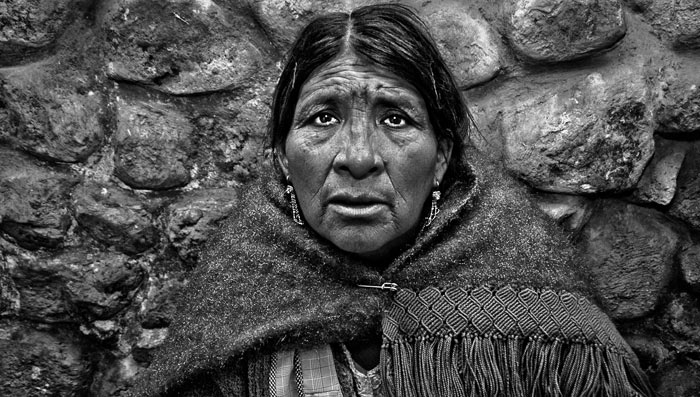
© 2010 Michelle Wong. All rights reserved.
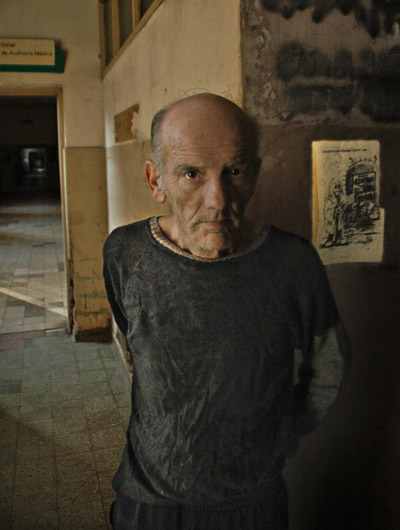
© 2010 Michelle Wong. All rights reserved.
Looking Ahead
Not satisfied with just art or technique, Wong hopes to put his skills to use by creating an organization that also imbues his work with a purpose. So far his work in the developing countries are a labor of love, with Wong seeking no financial compensation.
“In the long run it’s not about just fashion, or journalism,” he said. His plans include advocating for those who are rendered powerless by injustice and economy through images, journalism, analysis and legal recourse.
“If for any reason photos could create accountability and some degree of justice, that would be awesome.”
For Wong, faces will often convey more than words.
by Sonia Fernandez

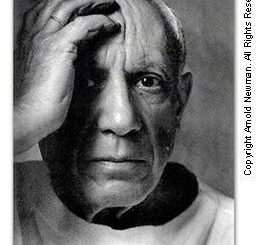
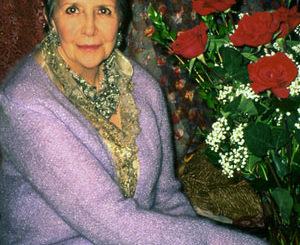
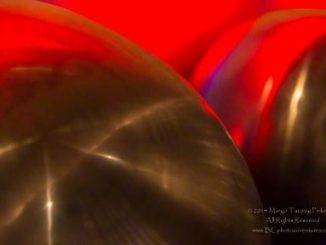
Leave a Reply